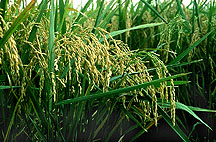Fueling the Green Revolution
|
|
The genes that sparked the Green Revolution came from unprepossessing wheat plants relegated to the ranks of agronomic curiosities. But their short, stiff straw and heavy seed heads caught the eye of ARS agronomist S. Cecil Salmon who was with Gen. Douglas MacArthur's headquarters in 1946 helping assess Japan's postwar agricultural problems. Salmon acquired seeds of 16 different strains—including one named Norin No. 10—for the World Small Grain Collection in Beltsville, Md. Within a year, the Collection processed and distributed the seeds to various U.S. wheat breeders. Some went to ARS-Washington State University breeders in Pullman. The Pullman team, led by ARS plant breeder Orville Vogel, analyzed the seeds' initial progeny for strengths and weaknesses. Over the next 13 years the scientists made many hybrid crosses and selections. One of the wheat varieties that came out of these efforts was the famed short-strawed Gaines. While hybridization was underway, Norman E. Borlaug of the International Maize and Wheat Research Centre, Mexico, visited Pullman and was impressed with the short-stalked wheat's potential. The group shared germplasm with Borlaug who, in turn, crossed it with Mexico's best wheats. In 1963 Borlaug responded to an urgent request from the government of India to tour its major wheat-growing regions and provide breeders with lines containing Norin No. 10 dwarfing genes. The tall native wheats had encountered an insurmountable yield barrier. When heavily fertilized with nitrogen, they grew too high, became top-heavy, and lodged. |
|
|
Borlaug's semidwarf wheats enabled India to finally launch its Green Revolution. The combination of new genes, fertilizer, and irrigation spurred wheat production from 12 million metric tons in 1965 to over 20 million in 1970 and over 37 million last year. Since the new wheats were broadly adapted, Green Revolutions also took hold in countries sharing similar latitudes, such as Pakistan, Turkey, and Afghanistan. For his contributions, Borlaug was awarded the Nobel Prize. Arid regions of India also benefited from a Green Revolution, one based on hybrid pearl millets. But an obstacle to hybridization had to be overcome first because many grasses, including millets, self-pollinate. ARS geneticist Glenn Burton altered pearl millet's cytoplasm to create the cytoplasmic male-sterile plants that made hybrids possible. In 1961, Burton sent male-sterile millet seeds to India for its breeding programs. By 1965 the Indian scientists developed a new hybrid that out-yielded native varieties by 88 percent. In that year, India produced 3.5 million tons of millet. Just 5 years later, millet production climbed to 8 million tons. That gain in yield accounted for 20 percent of the extra food production in India's Green Revolution. Plant breeders rely on the collection and preservation of still-extant germplasm. A major effort is underway to save from extinction not only the seeds of plants now cultivated but also their wild relatives with rich and irreplaceable genetic qualities—from resistance to disease and drought to higher yields. A wide variety of genetic material is essential if breeders are to improve and perpetuate the world's crops. Two internationally known facilities are maintained by ARS to help foster genetic diversity. The World Small Grain Collection, which can be traced to informal origins in the 1870's, serves as a "working" collection. It collects, maintains, distributes, and evaluates germplasm to meet the ongoing needs of plant breeders everywhere. At present, the Collection maintains some 102,000 strains of wheat, barley, oats, rice, rye, and triticale. On the other hand, the National Seed Storage Laboratory (NSSL), Fort Collins, Colo., is a "base" collection. It maintains, mostly in cold-storage rooms, over 200,000 separate collections of seed and vegetative stock. Some collections were obtained by expeditions to remote lands. Although the NSSL's germplasm may duplicate that in working collections, it releases material only when it is not available elsewhere. Its prime mission is to perpetually safeguard germplasm, an ultimate gene bank for the plant breeders working to help feed the world's burgeoning population.—(By Russell P. Kaniuka, Beltsville, Md.) |


